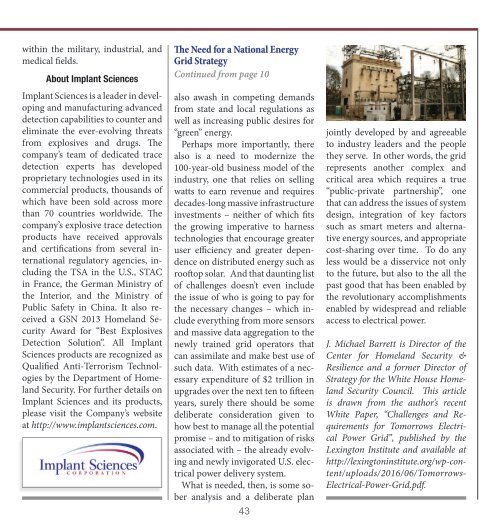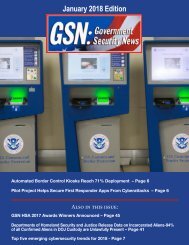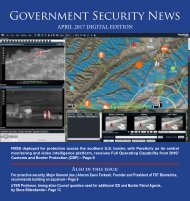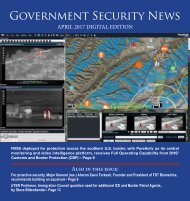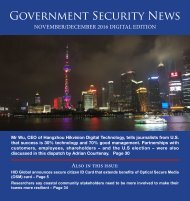Government Security News July 2016 Digital Edition
Government Security News, founded in 2001 shortly after 9/11, is a news and feature publication covering Homeland Security and Defense. It is read by government executives in federal, state, county, municipal agencies as well as technology vendors and service personnel in Law Enforcement, Airport and Aviation Security, Border Security and Immigration, Maritime and Port Security, Disaster Preparedness and Response, Counter-Terrorism, IT and Cybersecurity and all other branches of Government and the Military. In addition to its daily, weekly and monthly publications and newsletters, Government Security News also operates two awards programs that are well-respected in the U.S. and Internationally.
Government Security News, founded in 2001 shortly after 9/11, is a news and feature publication covering Homeland Security and Defense. It is read by government executives in federal, state, county, municipal agencies as well as technology vendors and service personnel in Law Enforcement, Airport and Aviation Security, Border Security and Immigration, Maritime and Port Security, Disaster Preparedness and Response, Counter-Terrorism, IT and Cybersecurity and all other branches of Government and the Military. In addition to its daily, weekly and monthly publications and newsletters, Government Security News also operates two awards programs that are well-respected in the U.S. and Internationally.
Create successful ePaper yourself
Turn your PDF publications into a flip-book with our unique Google optimized e-Paper software.
within the military, industrial, and<br />
medical fields.<br />
About Implant Sciences<br />
Implant Sciences is a leader in developing<br />
and manufacturing advanced<br />
detection capabilities to counter and<br />
eliminate the ever-evolving threats<br />
from explosives and drugs. The<br />
company’s team of dedicated trace<br />
detection experts has developed<br />
proprietary technologies used in its<br />
commercial products, thousands of<br />
which have been sold across more<br />
than 70 countries worldwide. The<br />
company’s explosive trace detection<br />
products have received approvals<br />
and certifications from several international<br />
regulatory agencies, including<br />
the TSA in the U.S., STAC<br />
in France, the German Ministry of<br />
the Interior, and the Ministry of<br />
Public Safety in China. It also received<br />
a GSN 2013 Homeland <strong>Security</strong><br />
Award for “Best Explosives<br />
Detection Solution”. All Implant<br />
Sciences products are recognized as<br />
Qualified Anti-Terrorism Technologies<br />
by the Department of Homeland<br />
<strong>Security</strong>. For further details on<br />
Implant Sciences and its products,<br />
please visit the Company’s website<br />
at http://www.implantsciences.com.<br />
The Need for a National Energy<br />
Grid Strategy<br />
Continued from page 10<br />
also awash in competing demands<br />
from state and local regulations as<br />
well as increasing public desires for<br />
“green” energy.<br />
Perhaps more importantly, there<br />
also is a need to modernize the<br />
100-year-old business model of the<br />
industry, one that relies on selling<br />
watts to earn revenue and requires<br />
decades-long massive infrastructure<br />
investments – neither of which fits<br />
the growing imperative to harness<br />
technologies that encourage greater<br />
user efficiency and greater dependence<br />
on distributed energy such as<br />
rooftop solar. And that daunting list<br />
of challenges doesn’t even include<br />
the issue of who is going to pay for<br />
the necessary changes – which include<br />
everything from more sensors<br />
and massive data aggregation to the<br />
newly trained grid operators that<br />
can assimilate and make best use of<br />
such data. With estimates of a necessary<br />
expenditure of $2 trillion in<br />
upgrades over the next ten to fifteen<br />
years, surely there should be some<br />
deliberate consideration given to<br />
how best to manage all the potential<br />
promise – and to mitigation of risks<br />
associated with – the already evolving<br />
and newly invigorated U.S. electrical<br />
power delivery system.<br />
What is needed, then, is some sober<br />
analysis and a deliberate plan<br />
43<br />
jointly developed by and agreeable<br />
to industry leaders and the people<br />
they serve. In other words, the grid<br />
represents another complex and<br />
critical area which requires a true<br />
“public-private partnership”, one<br />
that can address the issues of system<br />
design, integration of key factors<br />
such as smart meters and alternative<br />
energy sources, and appropriate<br />
cost-sharing over time. To do any<br />
less would be a disservice not only<br />
to the future, but also to the all the<br />
past good that has been enabled by<br />
the revolutionary accomplishments<br />
enabled by widespread and reliable<br />
access to electrical power.<br />
J. Michael Barrett is Director of the<br />
Center for Homeland <strong>Security</strong> &<br />
Resilience and a former Director of<br />
Strategy for the White House Homeland<br />
<strong>Security</strong> Council. This article<br />
is drawn from the author’s recent<br />
White Paper, “Challenges and Requirements<br />
for Tomorrows Electrical<br />
Power Grid”, published by the<br />
Lexington Institute and available at<br />
http://lexingtoninstitute.org/wp-con-<br />
tent/uploads/<strong>2016</strong>/06/Tomorrows-<br />
Electrical-Power-Grid.pdf.


